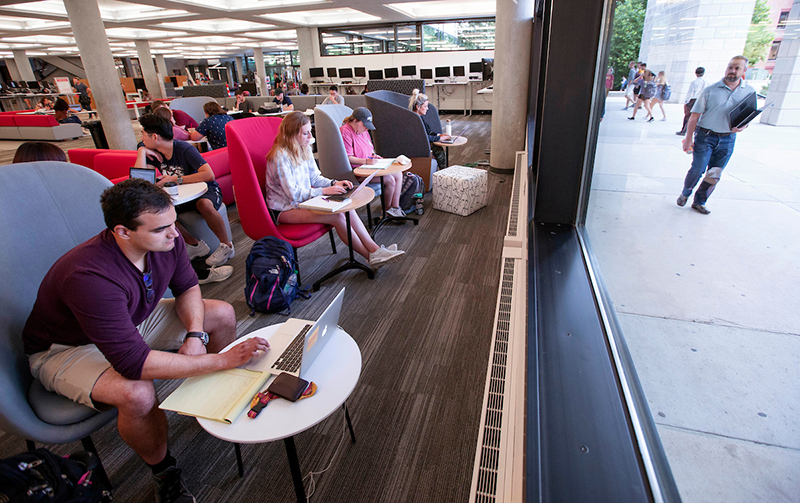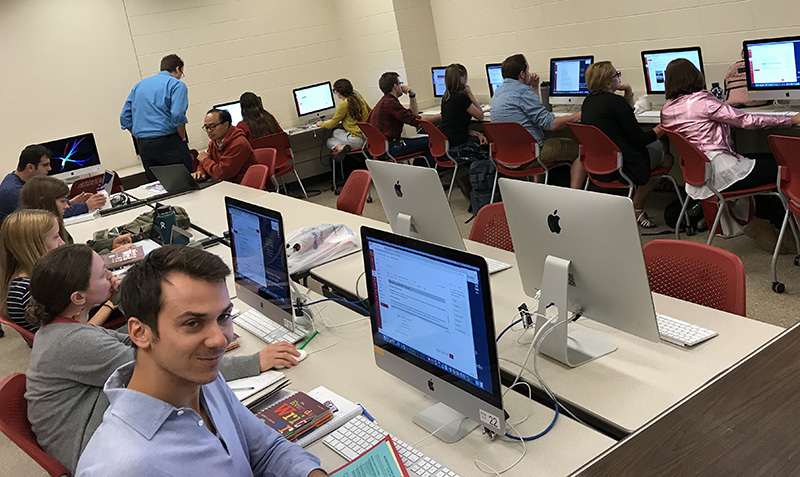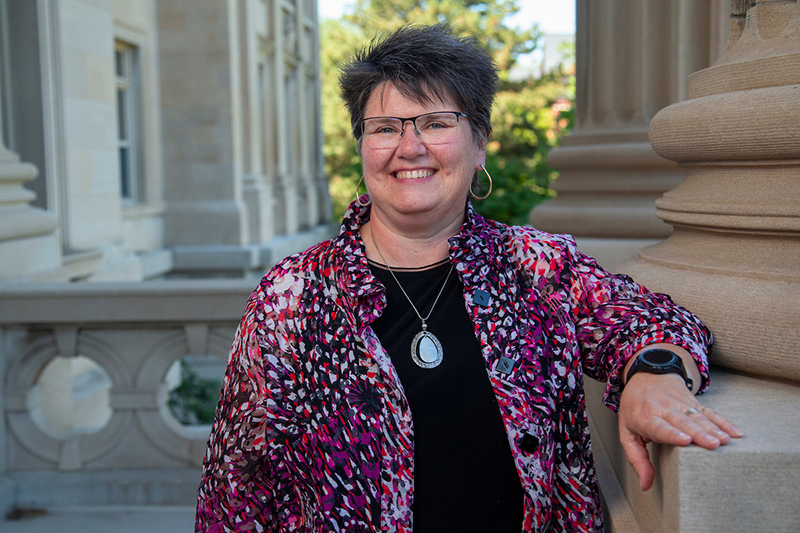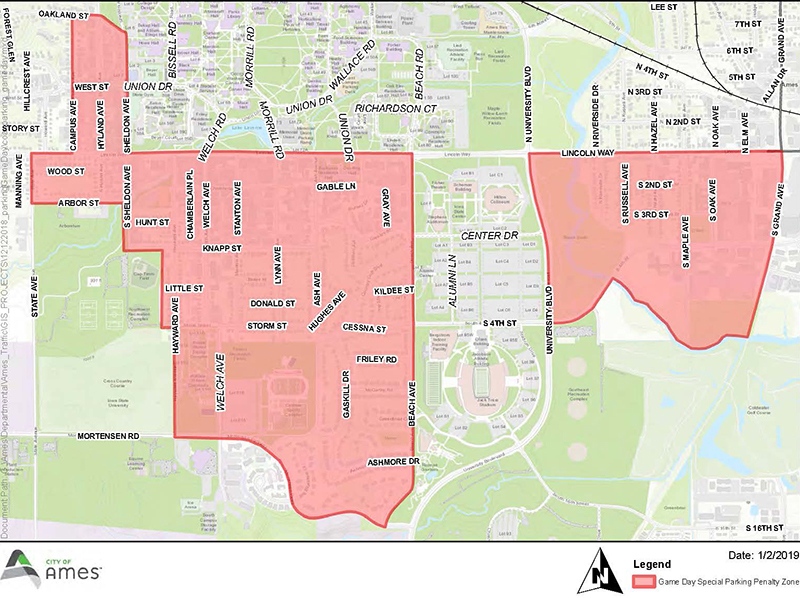A library to love

Photo by Christopher Gannon.
Global resource systems senior Joe Lavastida (left) was among the students who grabbed a chair in between classes Monday in the just-opened collaboration commons area in Parks Library's south first floor. On the former footprint of the circulation desk and staff offices, the summer renovation created six technology-equipped collaboration rooms, a reconfigured main desk and both community and individual study spaces. It features height-adjustable desks and lots of electrical outlets to accommodate electronic devices. The new collaboration rooms are equipped with interactive displays that combine several functions into one: touch/presentation screen that runs Windows applications, whiteboard and video/audio conferencing.
Soon, the new "main desk" (formerly the circulation desk) will begin operating just south of the open stairwell. Until it's ready, main desk services -- such as materials checkout and return, course reserve inquiries, group study room key pickup and return, and others -- are available at the temporary desk in the front lobby.
Library staff formerly housed in the south end of the first floor have relocated to other parts of the library; business services staff to the second floor (204) and course reserves staff to another part of first floor. Staff members who had desks within the circulation desk will move behind the main desk when it opens.
English TA orientation is an intense mix of practical tips and big picture

First-time teaching assistants for English 150 and 250 meet with an IT specialist on the final day of their weeklong orientation before the fall semester started. Photo by Dave Roepke.
The Friday before classes started, Lindsey Huber was full of nervous energy about teaching English 150 this semester -- the new graduate student's first turn at the front of the classroom.
"I have the level of excitement like I don't know if I'm cutting the red wire or the green wire," she said.
But she felt much more prepared on Friday than she did five days earlier. Huber and 20 other first-time teaching assistants for English 150 and 250 -- Iowa State's only graded courses required for all undergraduates -- spent the week in all-day orientation sessions, an intense introduction that combines big-picture motivation and a detailed look at the curriculum with pragmatic tips and practice.
New teaching assistants have varying levels of experience as educators, but some have none. The orientation is meant to prepare them for the classroom, with teaching guidance focused on three pillars, course director and associate professor Abram Anders said:
- Leading learning activities and presenting content
- Building relationships and providing supportive feedback
- Designing lessons and activities that are engaging and have impact
It's impossible to develop deep knowledge about teaching in five days, but graduate assistants are often among the most popular faculty with students, in large part due to their enthusiasm, Anders said.
"When you're starting in your career, it's true that you may not have learned every lesson that a more experienced instructor may have learned, and you may not be as refined in certain areas. But typically, teaching assistants bring so much energy and so much passion. They're so excited to be teaching," he said. "I honestly feel that from Day One, TAs can be amazing instructors. That's been my experience at all levels."
Laying foundation
TAs are essential in helping cover the large teaching load of English 150 and 250 -- the foundation courses of ISUComm, Iowa State's communication-across-the-curriculum program. This fall, there are 141 sections of the two courses combined, classes taught by 81 instructors. That would total 3,360 students if each section was full, Anders said. Combined enrollment for the year has been as high as 7,200 students, former director Barbara Blakely said in a 2018 interview.
In their first semester, new TAs have one section of English 150, often using a template syllabus, before expanding to two sections of English 250 in the spring. As they teach their fall section, they also take English 500, a course devoted to learning how to teach composition, and faculty give them feedback based on classroom observations. Many orientation topics are thumbnail versions of what's covered in English 500, said Edward Eason, an assistant teaching professor who helps lead the orientation.
"It's about laying that foundation of the essential ideas and skills they need to know for that first week," he said.
Many of the TAs have nuts-and-bolts questions, said associate teaching professor Amy Walton, an orientation instructor for four years. What should I wear? How should I introduce myself? How does grading work? Insecurity about being seen as an authority figure is common, especially for students who are coming directly to graduate school from undergraduate studies.
"They don't realize there's a mechanism already in place. Your students come in, and they see you as the instructor," she said. Making a strong first impression and showing consistency, like always starting class promptly, can maintain that momentum, she said. Scoping out the classroom ahead of time and practicing students' names are other confidence boosters.
Some sessions are more about inspiration. On orientation's first day, Anders said, the TAs are asked to recall the best teachers they've had -- to ponder what made them so good and to realize those instructors once taught for the first time, too.
But it is important to develop their own style, as well.
"You don't have to make yourself over into a cutout of some ideal teacher. You have to find a way of leveraging your strengths and supporting areas of growth where needed," Anders said.
Interactive experience
The orientation has evolved over time, Walton said. A component on English language learners was added because students often asked about it. When Anders took over as the course director this summer, he added more modeling and role-playing exercises, she said.
"Getting up in front of their peers can be scarier than in front of a classroom," Walton said.
No matter what ground they cover, it's a daunting but productive five days.
"The students by midweek, you can tell, get this sort of heaviness. We front load so much information," Walton said. "But by the end of the week, they can envision a successful semester."
Huber said she didn't know what to expect from the orientation, though she feared it was going to be "death by Powerpoint." She was pleasantly surprised by how helpful it was. Getting a look at what they'll be learning and knowing she's part of a diverse group navigating a new challenge provided peace of mind, Huber said. Working hands-on with Canvas helped, too.
"As a whole, the big takeaway was that we're all in this together," she said. "I think we established a really good resource community."
Alana Jones also went through the orientation sessions last week, and she had some of the same initial hesitation as Huber.
"When I saw the 8-to-5 schedule, I thought, 'Oh no!'" she said.
Instead, she was impressed by how interactive the sessions were and how directly they addressed her worries. Jones has experience coaching track and cross country but wasn't sure how to keep students engaged in a classroom. She said she picked up a lot of practical advice.
"I thought it was really in-depth and well-done," she said. "I feel a lot more confident than I did on the first day coming in."
Toolkit, workshop help instructors deal with disruptions
Last spring, the Faculty Senate passed revisions to the policy addressing disruptive conduct in a learning environment. Resources are available to help instructors identify and deal with situations that range from a single serious incident to frequent, unproductive interruptions.
The Center for Excellence in Learning and Teaching (CELT) provides a disruptive conduct toolkit on its website that may help instructors manage disruptive behavior. CELT also is in its second year of offering a 50-minute workshop on the subject.
"I don't think we have seen a rise in disruptions, it is just as we have larger classrooms or are teaching more students [disruptions] seem bound to happen," said CELT director Sara Marcketti.
Disruptive behavior toolkit
The toolkit, available since last spring, provides a guide on what instructors can do on the first day of class, and going forward, to clarify what they consider disruptive.
There are multiple examples of statements to add to a syllabus regarding disruptive behavior as well as a list of do's and don'ts when dealing with unwanted conduct. Responses are detailed for scenarios -- ranging from student academic misconduct to physically acting out.
When an action may be part of a bigger issue, the toolkit includes campus resources that provide help to students in need.
"Don't be afraid to contact student assistance or the dean of students office if you don't know what to do next," CELT program coordinator Laura Bestler said. "If instructors are not able to find what they are looking for in the toolkit or after attending a workshop, [student affairs staff] will be able to assist them with what steps to take next."
CELT workshop
The effectively managing disruptive conduct in learning spaces workshop was offered four times last year and will be offered twice this fall and spring, starting with the Oct. 1 program.
Participants complete activities to help them understand how to manage disruptions and learn more about available campus resources. They also go through active learning strategies to apply best practices in the growing number of places learning takes place, including classrooms, online, field trips or during office hours.
The CELT advisory board, made up of faculty, staff, and graduate and undergraduate students, provided feedback before the workshop launched.
When to take action
Each instructor decides differently when documentation of a disruption begins, but if a student displays disruptive behavior in one class, it is more than likely happening in others, Bestler said.
"Our No. 1 thing is to make sure our students are having a safe and productive experience while they are going to school," she said.
When an instructor decides there has been a disruption, one of the most important steps is documentation, including time, date, a brief description of the conduct and any action taken. That may include a conversation or email with a student, contacting the dean of students office or, with more serious matters, reaching out to ISU Police.
ISU uses a graduated approach to deal with these issues, and faculty have expressed concern over the potential time involved in documenting disruptions.
"I think it is really important to remember when something happens and you document it, that helps other people down the line. It helps the student down the line," Marcketti said. "We advise that instructors just take a minute and write down what went well and what they would change each day because days and months go by so fast. If you keep that running record, and do it consistently, it doesn't eat up as much time."
The toolkit has email templates to help instructors.
"It is a simple copy and paste and change a few things," Bestler said. "It is an easy way to document the behavior that instructors experienced."
Marcketti said instructors need to be aware that what is considered disruptive in one class may be acceptable in another, illustrating the need for clarity.
"It is easy to forget that students have three to five classes each semester, sometimes in many different colleges," she said. "As an instructor, you are so passionate about your class. Students are getting different messages from all over campus on what expectations are."
Welcome

Photo by Christopher Gannon.
Carolann Jensen became the state relations officer for Iowa State on Aug. 26 and said her first goal is to "immerse herself in all aspects of ISU." She invites members of the university community to contact her if they'd like to meet.
Jensen comes to Iowa State from the Iowa Finance Authority, Des Moines, where she had worked since 2011, as chief programs officer, chief operations officer and, for part of 2018, interim executive director. Previously, she spent 24 years as a senior research analyst for the Republican caucus in the Iowa Senate.
Jensen earned a bachelor's degree in public service and administration in agriculture from Iowa State and a master's degree in public administration from Drake University.
The state relations post is a shared position with the state Board of Regents, and Jensen will split her time between the two offices -- and the capitol complex during the legislative session. Her campus office is in 2810 Beardshear, and her desk phone is 294-7239. She also can be reached by email at cjensen3@iastate.edu or her cell phone 515-250-2585.
New parking ordinance in effect for ISU football games

Fines double within the red shaded zones for drivers who park illegally during ISU home football games. Image courtesy of the city of Ames.
One of Iowa State's most anticipated football seasons begins Aug. 31, but where fans park before entering Jack Trice Stadium to watch the Cyclones may change.
A new city game day parking ordinance goes into effect for the seven home games on the 2019 schedule.
Video
Recreation services director Mike Giles talks about the constuction near Jack Trice Stadium. The work being done does not impact game day parking.
It creates parking penalty zones with increased fines during home football games. Those illegally parked in the designated neighborhoods from 6 a.m. to midnight on game days will pay a $40 fine, double the previous amount. The city posted more than 500 signs in the areas to alert drivers and also will use portable message boards, sandwich boards and yard signs to remind drivers of the change. The Ames Police Department is responsible for enforcing the ordinance.
"For any change we have had through the city it is all based on neighborhood complaints, and I think it just finally built up to that point," Ames parking enforcement coordinator Sheri Nelson said. "We get out and enforce and write hundreds and hundreds of tickets, and it doesn't deter anyone from parking illegally when the paid parking is just as much as a city ticket and much closer to the stadium."
Penalty zones
There are penalty zones east and west of the stadium. Generally, the zones stretch from Lincoln Way east to State Avenue, west to South Grand Avenue and south to Mortensen Road. Parking is available on some streets, but drivers must obey all posted regulations.
As in many Ames residential neighborhoods, street parking in the penalty zones generally is limited to one side of the road. When vehicles park on both sides of a street it becomes a safety concern, and residents can have issues trying to enter or exit their driveways.
"A lot of the issues are in the south campus neighborhoods, and we are seeing the same issues east of the stadium," Nelson said.
How much of a deterrent the increased fine is, and if the penalty zones push parking issues farther from the stadium, could lead to other game day changes in the future, Nelson said.
Off-street options
Parking is available in game day lots and some campus lots. Cyclone Club parking lots open at 7 a.m. or six hours prior to kickoff, whichever is earlier. Public parking lots open six hours before kickoff.
"I encourage people to come early because there is some construction, and people may be parking in different locations than they are used to," ISU police chief Michael Newton said. "Give yourself extra time to get to where you want to be."
The city encourages fans to walk, use CyRide, park remotely or carpool to limit congestion near the stadium.
Tailgating
The athletics department's tailgating guidelines remain in effect for the 2019 season for the safety and enjoyment of all fans.
- Be considerate and respectful of others.
- Limit your tailgating to your one parking space. ISU parking staff will enforce the one-space-per-pass rule.
- Do not block the driving lanes for other vehicles parking or accessing parking lots or stalls.
- Maximum tent size is 10 feet by 10 feet.
- No glass bottles or kegs.
- No open fires.
- No tailgating from elevated surfaces such as vehicle beds, roofs or trailers.
- Professional sound equipment, for example, a DJ booth, is prohibited without prior written approval from the athletics department. Small "boom boxes" are permitted but should be contained to your area (70 decibels limit, about the volume of a hair dryer).
- Clean up your area and dispose of trash before departing.
State law prohibits hard liquor consumption or possession of an open bottle of hard liquor on public property -- which includes university parking lots. Tailgaters of legal age may consume beer and wine in the parking areas.The clear bag policy began at the stadium last year. Fans can carry either a clear tote bag no larger than 12-by-6-by-12 inches or a one-gallon plastic freezer bag into the stadium.
The athletics department also provides a list of prohibited items in the stadium.
Dinner dates announced for Stephens shows
Stephens Auditorium is offering themed dinners prior to seven shows in the performing arts series this year:
- "Beautiful: The Carole King Musical," Saturday, Oct. 19
- "Jersey Boys," Sunday, Nov. 3
- "The Color Purple," Friday, Jan. 17, 2020
- "Swan Lake" by the Russian National Ballet, Thursday, Feb. 13
- "Finding Neverland," Friday, Feb. 14
- Siberian State Symphony Orchestra, Monday, March 2
- "Waitress," Thursday, March 12
Dinners are held in the Scheman Building and begin two hours prior to show time. Each starts with a 30-minute social. Each themed dinner is prepared in-house by chef Jeff Schoening and includes salad, entree, starch, vegetable, dessert and a ticket for wine or beer. Menus will be announced closer to show dates and include a vegetarian option.
In addition to a meal, patrons enjoy early parking and Stephens' performance pre-check process. As guests check in for dinner, staff also scan their performance tickets, check bags and distribute pre-check passes. After dinner, guests use their pass to enter Stephens through a designated door -- avoiding lines and arriving at their seats before opening curtain.
Dinner seating is limited and reservations are filled on a first-come, first-served basis. Dinner tickets are $34, with the exception of the two February dates ($42), when a Valentine's Day menu will be served. Dinner tickets must be purchased in advance, either online or by phone, 294-2479.
Single-event tickets for all shows in the 2019-20 performing arts series went on sale Aug. 13 online or by phone through Ticketmaster, 800-745-3000, and at the Stephens ticket office.
